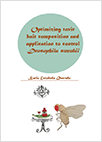PhD defence Karla Escobedo Quevedo
Karla Escobedo Quevedo (EGDB)
Promotor: Prof. B. wertheim; copromotor: Dr H.M. Helsen (WUR)

Optimizing toxic bait composition and application to control Drosophila suzukii
Invasive pest species are species that are not endemic to the ecosystem where they are found, that have established in this new environment, and that (are likely to) cause environmental or economic damage in these environments or harm to human health. The most commonly known deleterious effects an invasive pest species can cause are the extinction of endemic species, ecosystem alterations and economic losses by damaging an important food crop. Invasive pest species can be difficult to control due to the lack of suitable natural enemies, i.e. the invaded area is not prepared for them. Currently, there is a non-native species that has invaded almost all continents: scientifically known as Drosophila suzukii or commonly known as spotted wing drosophila (SWD).
Drosophila suzukii is a fruit fly that causes significant economic damage to the fruit growing industry, for stone fruits and soft fruits. Drosophila suzukii presents seasonal phenotypic plasticity by displaying traits that best suit the environmental conditions in spring/summer and autumn/winter. Adults emerge with different morphology and physiology in response to the temperature that they experience during larval and/or pupal development. This thesis focused on the development of an effective and sustainable bait spray strategy to control D. suzukii adult females. Bait sprays consist of a mixture of an insecticide and a food lure, aiming for insects to ingest or interact with the food lure, thereby facilitating the uptake of the insecticide. I investigated i) Foraging behavior of D. suzukii; ii) Food lure composition; iii) Biorational insecticides as a toxin; and iv) dsRNA as a toxin. In these investigations, I included both summer and winter morphs, to assess whether they respond similarly to the experimental treatments.
I found that understanding the foraging behavior of D. suzukii plays an important role in the application of bait sprays. My laboratory results showed that the position where a bait spray is placed influenced the chances for it to be encountered by the flies, with more feeding towards the upper part of the plant. I observed that most of the flies approached the bait by walking up the stalk and then exploring the leaf surface. When exploring and once the flies had encountered a food stimulus, they spent time on it, even on an non-attractive bait. Based on this, I concluded that a food lure should not necessarily be long-distance attractive to be used in bait sprays, as long as it is applied where the pests are expected to come into contact with it. Upon further study of the composition of a food lure, I found that its makeup, primarily its nutritional value, impacted the interaction of the flies with the food lures. Flies did not show a strong preference for a sugar- or yeast-based food lure when these were offered at the same time. Overall, I observed differences in feeding preferences, resistance towards starvation and mobility between summer and winter morph flies.
Then, I investigated the toxin component of bait sprays by comparing different biorational insecticides. Biorational insecticides are formulated from plants or oil extracts, microorganisms, minerals and natural products and are relatively innocuous to non-target organisms. I did experiments in Mexico and in the Netherlands. I could not directly compare the results, because the insecticides were from different manufacturers and the recommended doses were also different. However, in both experiments, the results were similar, in that the biorational insecticides tested were not sufficiently toxic to control D. suzukii. Hence, another approach is needed. I explored the possibility of using RNAi-based insecticides mixed with a food lure to control D. suzukii. RNAi-based insecticide is a technology based on silencing a vital gene of a pest species via the administration of double-stranded RNA (dsRNA) to the pest insect. Gene transcript knockdown of a vital gene can cause mortality to the target species. RNAi-based insecticides are considered biodegradable (i.e. they do not accumulate in the environment). Moreover, they can be designed to be highly species specific and thus would fit very well in Integrated Pest Management strategies. However, I observed neither gene silencing nor mortality. Because of its potentially great benefits, I recommend continuing research on this technique to elucidate the mechanisms for delivering dsRNA in D. suzukii cells.
This thesis provided new knowledge on D. suzukii females feeding behavior. The characterization of the forementioned behavior has direct implications on optimizing bait sprays strategy to control D. suzukii. Additionally, I believe that a bait spray strategy has a potential to be combined with dsRNA to target a specific vital gene in D. suzukii. It is important to mention that experiments were done under laboratory conditions and need to be extrapolated to agriculture settings. I therefore recommend experiments in field conditions.
